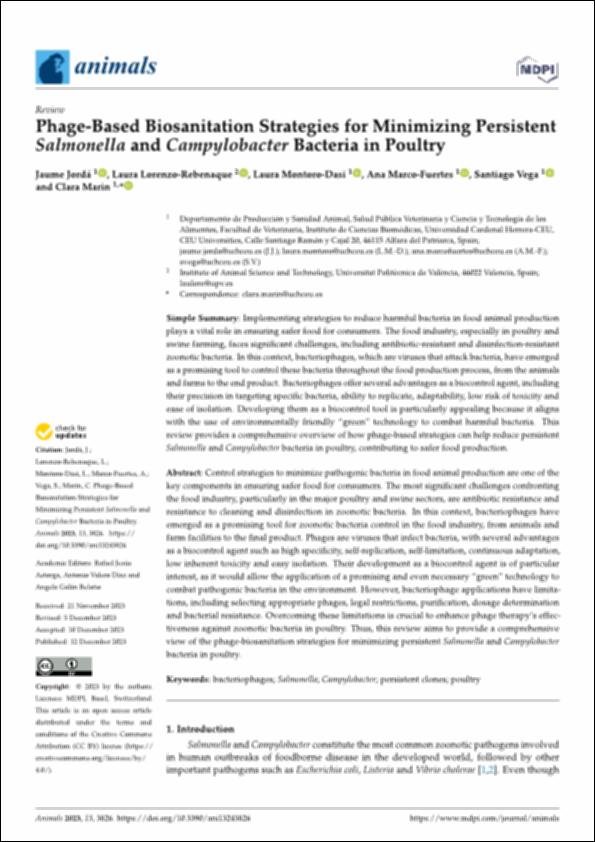Por favor, use este identificador para citar o enlazar este ítem:
http://hdl.handle.net/10637/15312Phage-based biosanitation strategies for minimizing persistent "Salmonella" and "Campylobacter" bacteria in poultry
| Título : | Phage-based biosanitation strategies for minimizing persistent "Salmonella" and "Campylobacter" bacteria in poultry |
| Autor : | Jordá Moret, Jaume Vicent Lorenzo Rebenaque, Laura Montoro Dasí, Laura Marco Fuertes, Ana Vega García, Santiago Marín Orenga, Clara |
| Materias: | Bacteriófagos; Bacteriophages; Aves de corral; Poultry; Producción alimentaria; Food production; Vibriosis; Salmonelosis en los animales; Salmonellosis in animals |
| Editorial : | MDPI |
| Citación : | Jordá, J., Lorenzo-Rebenaque, L., Montoro-Dasi, L., Marco-Fuertes, A., Vega, S. & Marin, C. (2023). Phage-based biosanitation strategies for minimizing persistent "Salmonella" and "Campylobacter" bacteria in poultry. Animals, vol. 13, i. 24 (dec.), art. 3826. DOI: https://doi.org/10.3390/ani13243826 |
| Resumen : | Control strategies to minimize pathogenic bacteria in food animal production are one of the key components in ensuring safer food for consumers. The most significant challenges confronting the food industry, particularly in the major poultry and swine sectors, are antibiotic resistance and resistance to cleaning and disinfection in zoonotic bacteria. In this context, bacteriophages have emerged as a promising tool for zoonotic bacteria control in the food industry, from animals and farm facilities to the final product. Phages are viruses that infect bacteria, with several advantages as a biocontrol agent such as high specificity, self-replication, self-limitation, continuous adaptation, low inherent toxicity and easy isolation. Their development as a biocontrol agent is of particular interest, as it would allow the application of a promising and even necessary “green” technology to combat pathogenic bacteria in the environment. However, bacteriophage applications have limitations, including selecting appropriate phages, legal restrictions, purification, dosage determination and bacterial resistance. Overcoming these limitations is crucial to enhance phage therapy’s effectiveness against zoonotic bacteria in poultry. Thus, this review aims to provide a comprehensive view of the phage-biosanitation strategies for minimizing persistent Salmonella and Campylobacter bacteria in poultry. |
| URI : | http://hdl.handle.net/10637/15312 |
| Derechos: | Open Access http://creativecommons.org/licenses/by/4.0/deed.es |
| ISSN : | 2076-2615 (Electrónico) |
| Fecha de publicación : | 12-dic-2023 |
| Centro : | Universidad Cardenal Herrera-CEU |
| Aparece en las colecciones: | Dpto. Producción y Sanidad Animal, Salud Pública Veterinaria y Ciencia y Tecnología de los Alimentos |
Los ítems de DSpace están protegidos por copyright, con todos los derechos reservados, a menos que se indique lo contrario.


